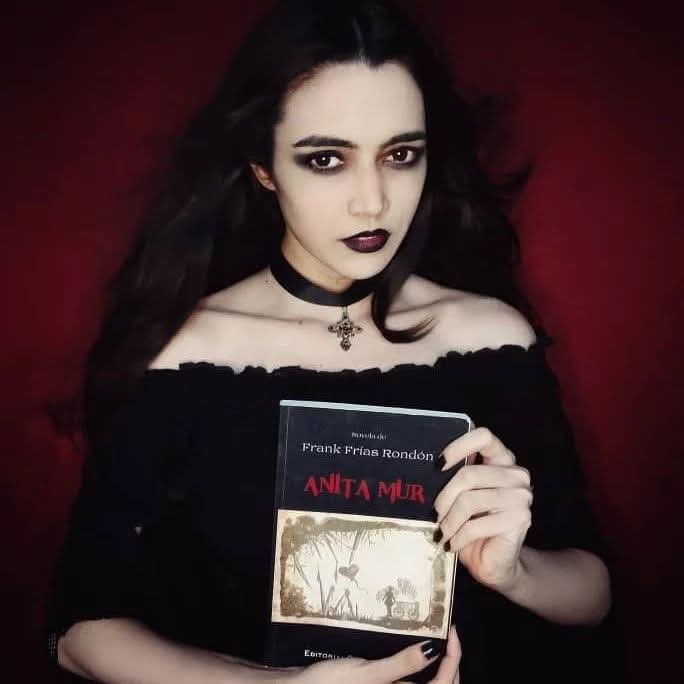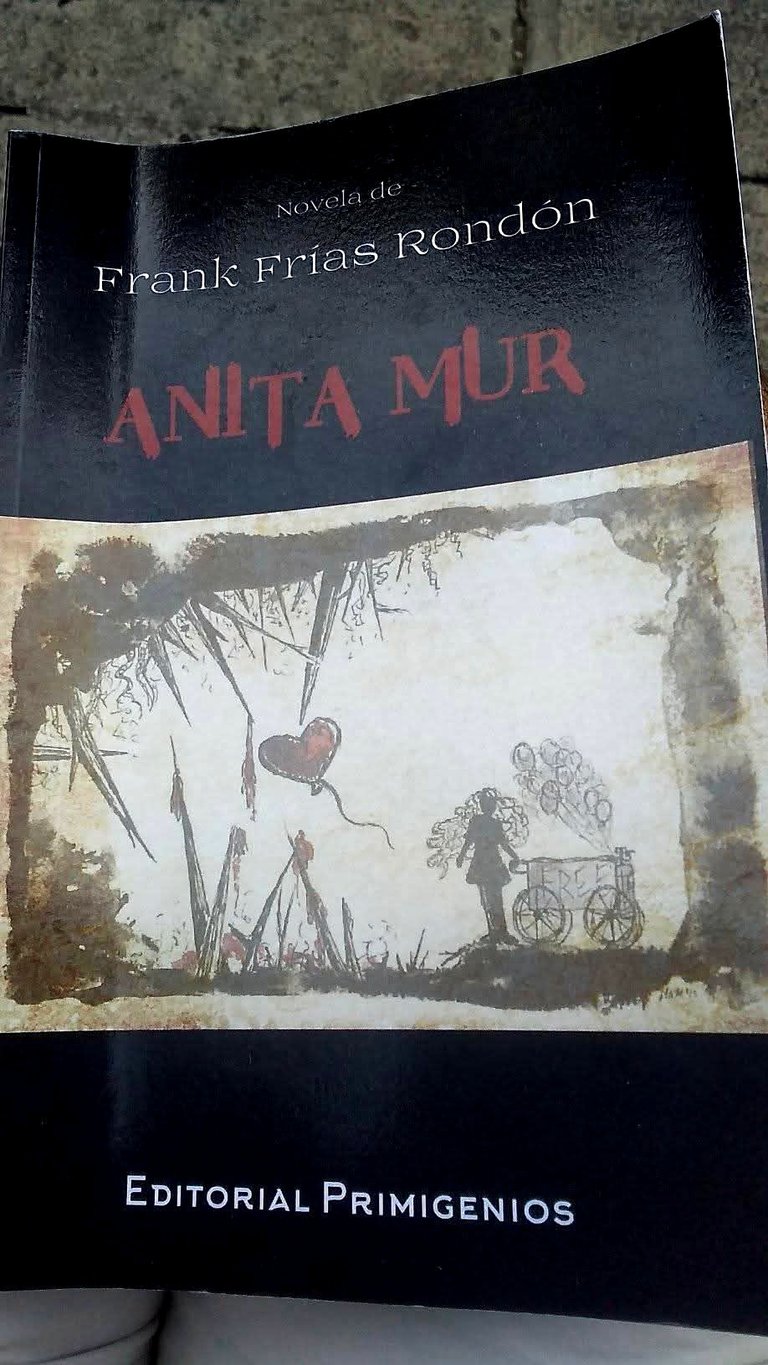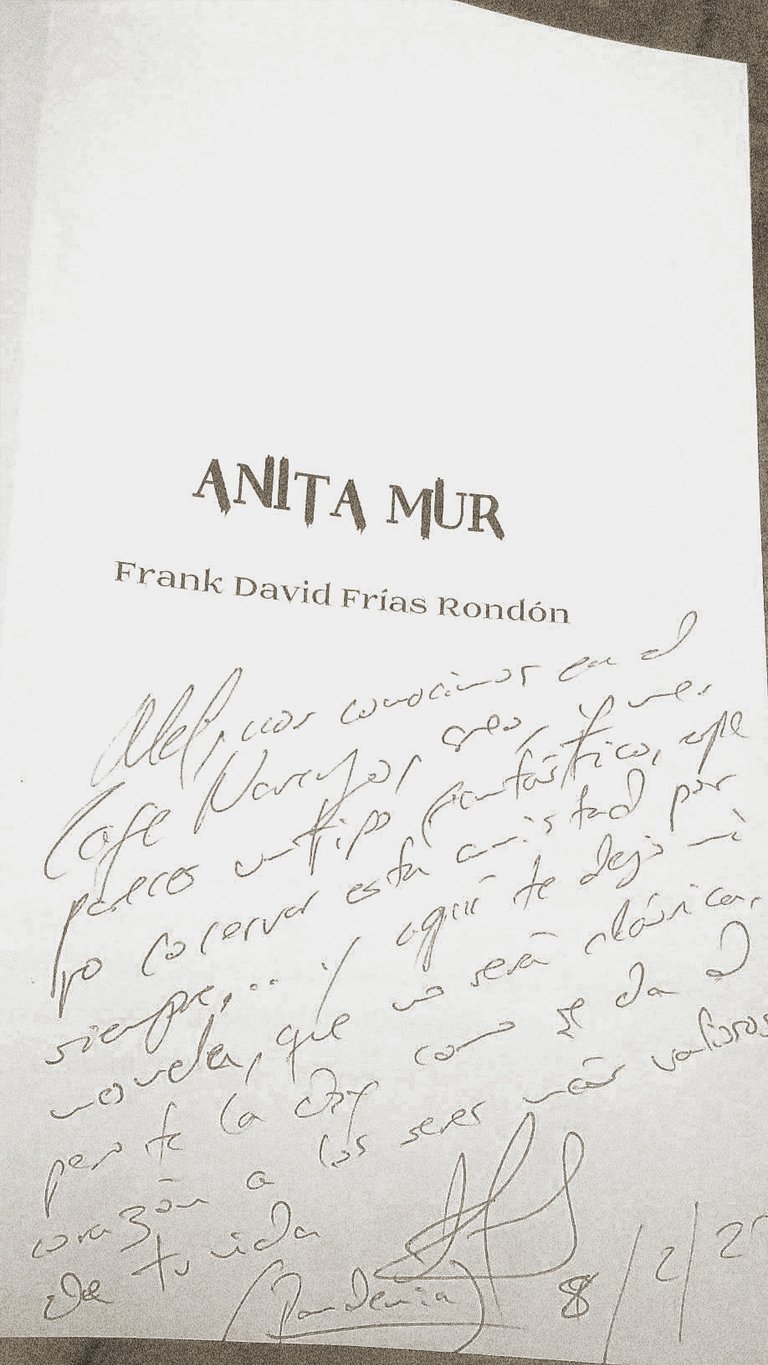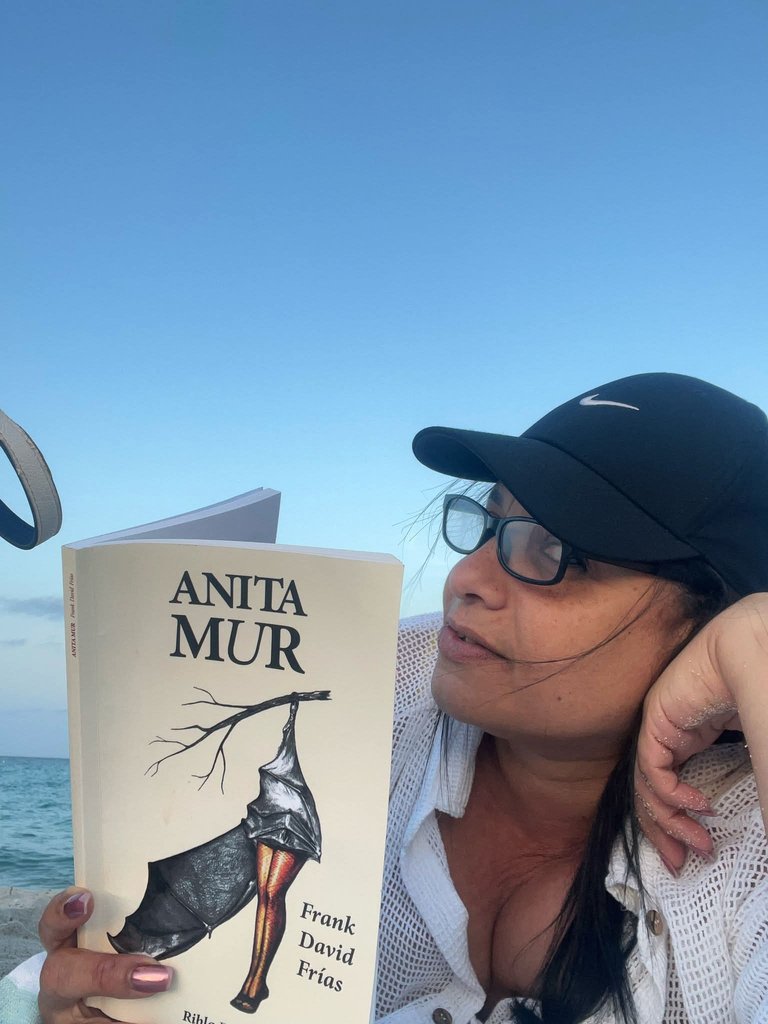Anita Mur: Todo es un balance perfecto / Anita Mur: Everything is a perfect balance (esp-eng)
Hola amigos de los libros. Hoy les traigo una novela que me dió muchas alegrías.

imagen cortesía del autor
Cuando comencé a leer la novela Anita Mur, del escritor cubano Frank David Frías Rondón (publicada por la Editorial Primigenios, en una primera edición del 2020 y luego por Ribla Editores, en su segunda edición del 2023) lo primero que me vino a la mente fue “esto es una historia de amor preciosa” y enseguida me tuve una mezcla de sensaciones encontradas.

Toda la novela transcurre en un balance perfecto: de emociones, estructura, técnicas, personajes, vivencias. Por un lado, el augurio de violencia y sangre, y del otro lado, el hermoso y sexy recuerdo de aquella colegiala recordada por el protagonista, en una costa habanera, con un hueco en el blúmer.
Desde ese mismo momento Frank David comienza a realizar la narración de texto nostálgico; repleto de precisas descripciones sinestésicas donde logra sumergir al lector dentro del texto, hacerlo parte de él.
En Anita Mur logras oler y ver todo en 360 grados con gran nivel de detalles. Incluso puedes sentir el frío, el paso del tiempo, las emociones y la brisa invernal de un mes de febrero frente al mar, personaje recurrente durante toda la novela.
Frank David logró, mediante sus descripciones, que parezca que la novela parezca envuelta en un hermoso velo gris invierno londinense (quizás uno de los velos que usualmente usaba la protagonista de la novela). Este es un efecto que le brinda esa atmósfera de misterio, belleza y nostalgia al texto. Logra dar vida a su novela hasta el punto en que el lector logra notar que Anita Isabel Fiss es una persona real envuelta en una trágica, romántica y hermosa historia de amor.
Las increíbles, precisas y originales descripciones no son el único logro del autor de la novela, pero quizás sí la base, cimiento o matriz de todo el libro. En Anita Mur todo funciona como un organismo vivo. Al igual que el argumento, todo parece hilado, entrelazado como un hermoso lienzo en cuatro dimensiones. Exacto, en cuatro dimensiones, ya que Frank David ha planteado su historia a través del tiempo de forma tan precisa que el lector no se pierde ni un instante y se encuentra ubicado en tiempo y espacio en todo momento. Resulta muy interesante uso de la retrospectiva en una complicada historia que abarca desde la época de inicios de los años 90 hasta la actualidad.
Frank David no ha necesitado recurrir a una magdalena para los saltos temporales o espaciales. Tampoco decirlo de forma explícita. Estos suceden de manera tan fluida y precisa, gracias al uso de diversas técnicas narrativas y capturas exactas del momento histórico narrado. Un ejemplo de esta afirmación es el capítulo cuando se narra la época del “período especial” cubano. El autor nunca menciona esas palabras ni los protagonistas realizan queja alguna. Sin embargo, el lector es capaz de identificar cada fase de este período a través de las escenas vividas/sufridas/disfrutadas por estos personajes. Me impresionó leer sobre este tema, en apariencia tan gastado por otros escritores, y que funcionara de maravilla y actual en estos momentos. Nada demodé. Esto prueba además que se puede escribir sobre cualquier tema con éxito, mientras se escriba bien. Este es uno de los casos.
Otro aspecto destacable en Anita Mur es la riqueza y dominio del lenguaje. La novela está plagada de un excelente uso de metáforas, símiles y analogías exquisitas y propias, con los cuales el autor, no solo economizó recursos narrativos, sino que enriqueció el texto con imágenes precisas y siempre de acorde al momento específico de la historia.
Como bonus extra, (ya que no es la idea del autor, sino mi opinión como lector), Anita Mur puede parecer una crítica a la sociedad actual cubana, en la que se deja claro que nada ha cambiado de 1980 hasta la actualidad.

En esta novela/organismo vivo que es Anita Mur, lo que más me impresiona es su estructura y evolución. Frank David no realiza la clásica estructura cíclica. Más bien, es una espiral conformada por espirales narrativas en su interior. La novela está conformada por pequeñas narraciones que comienzan y se van enlazando con otras y viajan del presente al pasado como si tuvieran voluntad propia. Como un organismo vivo. Son anillos/historias/espirales donde cada palabra cuenta y nada sobra. Ni siquiera el hueco del blúmer de Ana Isabel, la foto entre los pilotes, ni el loco del barrio, ni siquiera el clima. Todo en Anita Mur está pensado para que funcione como un ancla, como un símbolo, como una pista para el lector. No puedes dejar de leer/oir/ver/oler/experimentar nada de lo que Frank David pone a tu disposición. Cada letra, signo de puntuación está meticulosamente pensado para el disfrute de esta hermosa historia. Una prueba de esto te la da la propia Anita al inicio cuando advierte: “recuerda esto —me dijo mientras exprimía la saya—, tiene un significado.”
Y vaya si tenía razón. Todo lo tiene.

imagen cortesía del autor
Anita Mur es una novela equilibrada en todo sentido. Como en toda historia de amor, hay luces y sombras, alegría y felicidad. Quizás es por eso que sus personajes se sienten tan vivos, sus escenas tan familiares y el lector logra sentirse identificado con la historia desde la primera página hasta la última. Este es un texto donde se disfruta tanto del viaje, como del arribo al destino final.
Como dije al inicio, Anita Mur es una historia de amor. Pero no el amor de las novelas rosa de antaño. El amor entre Abel y Ana Isabel Fiss es real. No está edulcorado. Frank David narra todo lo que sucede o puede suceder en una relación verdadera. O sea, el amor perfecto, ese que acepta y reconoce las imperfecciones de cada uno. El amor de las parejas que se apoyan, que se aman, gustan, desean y no juzga: el amor incondicional y eterno. Anita Mur también está repleto de momentos felices, acción, sexo, escenas de gran erotismo, alegría, bromas y felicidad.
El libro entero parece una fotografía de esta hermosa historia. Quizás por eso el uso de la foto de Anita que conserva el protagonista y reaparece a cada rato a modo de leitmotiv y te hacen pensar en que Anita Mur es ahora, y así será siempre un texto tal y como dice la propia protagonista: “limpia y con brillo destacando entre tanta mierda. Dura igual que los pilotes de este río”.
English Version
Hello book lovers. Today I'm bringing you a novel that gave me a lot of joy.

image courtesy of the author
When I started reading the novel Anita Mur, by Cuban writer Frank David Frías Rondón (published by Editorial Primigenios in its first edition in 2020 and then by Ribla Editores in its second edition in 2023), the first thing that came to mind was "this is a beautiful love story," and I immediately felt a mixture of conflicting feelings.

The entire novel unfolds in a perfect balance: emotions, structure, techniques, characters, experiences. On one hand, the foreboding of violence and blood, and on the other, the beautiful and sexy memory of that schoolgirl remembered by the protagonist, on a Havana coast, with a hole in her panties.
From that very moment, Frank David begins to narrate a nostalgic text; full of precise synesthetic descriptions that manage to immerse the reader within the text, making them a part of it.
In Anita Mur, you can smell and see everything in 360 degrees with a great level of detail. You can even feel the cold, the passage of time, the emotions, and the winter breeze of a February seaside retreat, a recurring character throughout the novel.
Through his descriptions, Frank David made it seem as if the novel were wrapped in a beautiful gray London winter veil (perhaps one of the veils the novel's protagonist usually wore). This effect lends the text an atmosphere of mystery, beauty, and nostalgia. He brings his novel to life to the point where the reader realizes that Anita Isabel Fiss is a real person wrapped in a tragic, romantic, and beautiful love story.
The incredibly precise, original descriptions are not the author's only achievement, but perhaps the foundation, the basis, or the matrix of the entire book. In Anita Mur, everything functions like a living organism. Like the plot, everything seems woven together, intertwined like a beautiful four-dimensional canvas. Exactly, in four dimensions, since Frank David has presented his story over time so precisely that the reader never gets lost for a moment and finds themselves situated in time and space at all times. This is a very interesting use of flashback in a complicated story that spans from the early 1990s to the present.
Frank David didn't need to resort to a simple process for the jumps in time or space, nor did he need to explicitly state them. These happen so fluidly and precisely, thanks to the use of diverse narrative techniques and precise captures of the historical moment being narrated. An example of this is the chapter that narrates the era of Cuba's "Special Period." The author never mentions those words, nor do the protagonists make any complaints. However, the reader is able to identify each phase of this period through the scenes experienced/suffered/enjoyed by these characters. I was impressed to read about this theme, seemingly so worn out by other writers, and that it worked wonderfully and is relevant today. Nothing outdated. This further proves that you can write about any topic successfully, as long as you write well. This is one such example.
Another notable aspect of Anita Mur is the richness and mastery of language. The novel is filled with an excellent use of exquisite and unique metaphors, similes, and analogies, with which the author not only economized on narrative resources but also enriched the text with precise images always in keeping with the specific moment in history.
As an added bonus (since this is not the author's intention, but my opinion as a reader), Anita Mur may seem like a critique of current Cuban society, making it clear that nothing has changed from 1980 to the present. 
In this novel/living organism that is Anita Mur, what impresses me most is its structure and evolution. Frank David doesn't use the classic cyclical structure. Rather, it's a spiral made up of narrative spirals within it. The novel is made up of small narratives that begin and connect with others, traveling from the present to the past as if they had a will of their own. Like a living organism. They are rings/stories/spirals where every word counts and nothing is left over. Not even the gap in Ana Isabel's underwear, the photo between the stilts, the crazy guy in the neighborhood, not even the weather. Everything in Anita Mur is designed to function as an anchor, a symbol, a clue for the reader. You can't stop reading/hearing/seeing/smelling/experiencing anything Frank David puts at your disposal. Every letter, punctuation mark is meticulously thought out for the enjoyment of this beautiful story. Proof of this is given by Anita herself at the beginning when she warns: "Remember this," she told me while wringing out her skirt, "it has a meaning."
And boy, was she right. It has everything.

image courtesy of the author
Anita Mur is a balanced novel in every sense. As in every love story, there are lights and shadows, joy and happiness. Perhaps that's why its characters feel so alive, its scenes so familiar, and the reader can identify with the story from the first page to the last. This is a text where you enjoy both the journey and the arrival at the final destination.
As I said at the beginning, Anita Mur is a love story. But not the love of the romance novels of yesteryear. The love between Abel and Ana Isabel Fiss is real. It's not sugarcoated. Frank David narrates everything that happens or can happen in a true relationship. In other words, perfect love, the kind that accepts and acknowledges each other's imperfections. The love of couples who support each other, who love each other, like each other, desire each other, and don't judge: unconditional and eternal love. Anita Mur is also full of happy moments, action, sex, scenes of great eroticism, joy, jokes, and happiness.
The entire book seems like a photograph of this beautiful story. Perhaps that's why the use of the photo of Anita, which the protagonist keeps and reappears frequently as a leitmotif, makes you think that Anita Mur is now, and will always be, a text just as the protagonist herself says: "clean and shiny, standing out among so much shit. Lasts as long as the pilings in this river."
So it's just an ordinary world and end extraordinary story, told with a unique voice? Is it written in the first or third person?
Books thay cover years and years always impress me, when each and every one of those years isn't necessarily part of the puzzle.
Time jumps are hard in fiction. Does this one skips months or years, or is something always happening to keep the pacing steady?
I dislike it when perspective in story shifts suddenly to three years later and suddenly theres a whole bunch of character development or otherwise anticipated events missing.
The novel is narrated in retrospect, so while the jumps are several years, the protagonist is an adult and is recounting something that happened during his early adolescence. However, in the present, things also happen in adulthood that are linked to the past.
Cool, thank you! Sounds like an interesting way for the story to unfold.
@topcomment
Your reply is upvoted by @topcomment; a manual curation service that rewards meaningful and engaging comments.
More Info - Support us! - Reports - Discord Channel
Aún no he logrado leerla.
Ahora, al ver esta reseña magnífica, ¡sin dudas tengo más necesidad de poderme sumergir en ella!